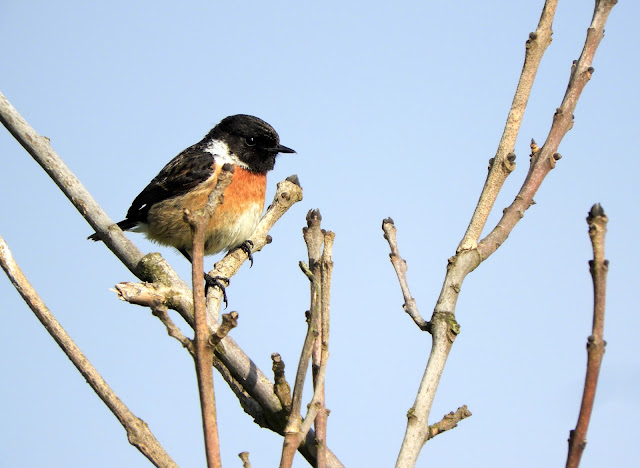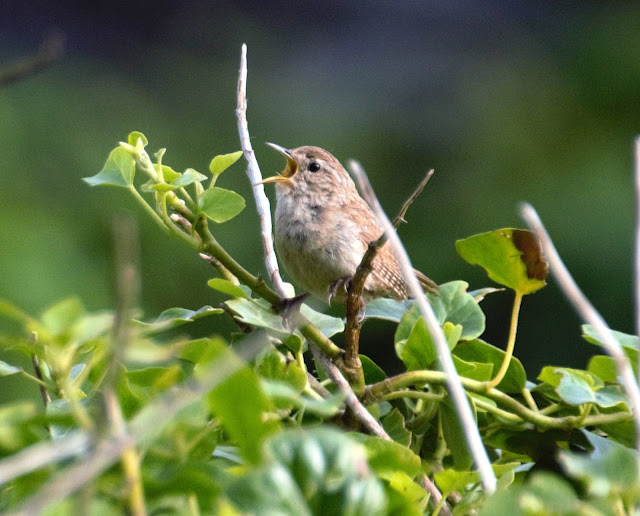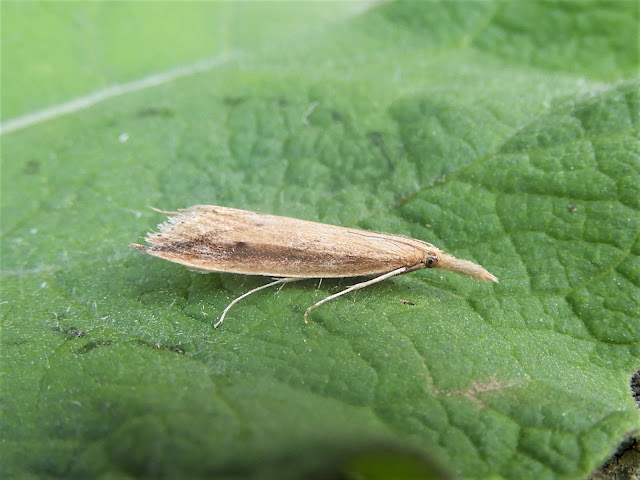Dean Jones pens another mega-roundup of the latest goings-on in the summer whirl of Lundy birds and other wildlife.
A slightly quieter period compared to all the happenings of the last blog (we’re still buzzing on the seabird census results and the Sulphur-bellied Warbler) – that said, the period since has still been a very eventful and exciting one. The island is still exuding a midsummer splendour and is bustling with events and interesting wildlife sightings, such as jangling post-breeding flocks of Linnets which are now starting to form across the island and an eruption of Heath Spotted Orchids around Pondsbury (118 flowering plants counted on the 6th), while Rosechafers are plentiful, particularly on clumps of flowering honeysuckle on the east coast, and small numbers of Harbour Porpoise and Common Dolphin have been breaching from glass-like seas on a number of dates.
Weather-wise, it has been mostly calm and bright, though the island has received a decent fall of rain since the last post – 97mm³ to be precise – all of which has been very welcome following what was a very dry June. The 6th and 12th July kicked this trend however, with some strong south-westerly winds and noticeably cooler temperatures which made the day feel much more autumn-like.
Birds of note through this period included small numbers of Swifts heading south over seven days (max 30 on the 30th), singles of Cuckoo on the 26th (east coast) and 30th (Threequarter Wall), a Turtle Dove in the Quarter Wall area on the 3rd, singles of Collared Dove on the 28th and 30th, a Ringed Plover over the North End on the 2nd, singles of Curlew on the 28th, 30th, 1st and 2nd (perhaps the same individual touring the island), a Sparrowhawk looking for a meal in the Camping Field on 29th, and two Grey Herons on the 2nd and a single bird on the 8th.
 |
| Cuckoo being mobbed by Meadow Pipits at Threequarter Wall, 30 Jun © Dean Jones |
 |
| Collared Dove, High Street, 30 Jun © Dean Jones |
 |
| One of two Grey Herons off the Terrace, 2 Jul © Dean Jones |
Small numbers of hirundines have been logged too on a number of dates, namely House Martins (max two on the 1st) and Sand Martins (max 14 on the 30th) already on their way south. Two Willow Warblers have been singing most days from both Millcombe and St Helen’s Copse, and the Millcombe Song Thrush is still singing away from the treetops of Millcombe wood most days – though for much shorter periods of time compared to earlier in the year. Finches too are on the move, with a single Siskin on 4th and small numbers of Goldfinch (e.g. two south over Jenny’s Cove on the 30th). Finally, two Crossbills were seen and heard in Millcombe on the 28th.
 |
| Male Stonechat, Lower East Side Path, 26 Jun © Dean Jones |
 |
| A fledgling Wheatear near Quarry Cottages, 28 Jun © Dean Jones |
The seabird season has progressed at a rapid pace since the last post, with many of the island auks now out on the high seas. On the St Mark's Guillemot plot all but two young birds are left as of the 11th. Although the numbers still need to be properly worked through, it appears that productivity at this site is slightly down on last year. Even though we only get brief insights into this spectacular seabird's breeding season (we’d love to spend more time on the slopes but other duties beckon), we think this drop in productivity is due to a higher level of predation this year, the flooding of some of the ledges (e.g. we lost 13 eggs in sub-site three after two days of heavy rain at the end of May), and a handful of unfertile eggs which the parent birds were still starting to incubate right up until 2nd Jul – though more than likely there are other unseen factors also influencing these birds. Although it is always sad to see a drop in productivity, 232 breeding attempts took place in this plot this year, the highest number of attempts recorded here since these studies began in 2007.
The Jenny’s Cove Puffins are seemingly having a great year, with fish being delivered to 287 burrows over the course of just over five weeks (compared to 261 apparently active burrows in 2020)! Additionally, the first puffling of the year was seen on 30th Jun – one day earlier than the first of 2020 – and fewer and fewer burrows are being provisioned each day, meaning that some of the young birds have already made the jump out to sea! Others haven’t been that lucky, as a few loafing birds on the slopes have been taken by Great Black-backed Gulls. Despite this, there have been some super numbers of Puffins on the slope (well for Lundy anyway), particularly during the evenings, e.g. 242 birds on the productivity slope on the evening of 9th Jul.
Unfortunately, our Kittiwakes are having a poor season productivity-wise, with 68 of the original 124 nests failing so far over the two sites. Again, like the Guillemots, there is seemingly a higher level of predation at both sites this year by Lesser Black-backed and
Herring Gulls. However, unlike the auks, there have also been a number of dead chicks found in nests, as well as multiple instances of siblicide noted, which is perhaps indicative that some birds are struggling to find enough food this year. Saying that, numerous other unseen factors are more than likely to be influencing the breeding season. Let’s hope the remaining chicks manage to fledge safely over the next few weeks.
The Conservation Team also managed a trip to the North End on the 2nd to look for occupied Storm Petrel burrows. Here the team set out for a morning of playing recordings of Storm Petrel calls down suitable burrows. A total of 13 birds responded across a small section of the North End, though there were definitely more birds present, hinted by the presence of lots of distinctively smelly burrows. Excitingly, some of these responses came from areas where birds have not been found in the past, including some of the old walls built by Trinity House in the late 1800s/early 1900s.
As not all breeding Storm Petrels respond to calls played down their burrows, an adjustment is needed in order to get a better population estimate. The published conversion factor applied to Storm Petrel colonies without calibrations of their own is 2.4, based on the median response rate of 0.42 (Mitchell et al. 2004). In surveys conducted by the RSPB in 2018, the team managed to elicit seven responses from the same site, which after applying the conversion factor gave an estimate of around 11 apparently occupied sites (AOS). Applying the same conversion factor to this year’s responses produces an average of 31 AOS – nearly triple the numbers estimated just three years ago! If you’d like to read the 2018 Storm Petrel report, you can do so via the following Lundy Field Society link: http://lfs-resources.s3.amazonaws.com/ar68/LFS_Annual_Report_Vol_68_Part_17.pdf
Also on 2nd Jul, long-standing Lundy birder Chris Baillie (whose first visit dates back to 1968!) made another exciting discovery whilst spending part of the day exploring an area of boulder scree below the Battery. Here Chris found a number of 'Stormie' burrows in a site that we always thought birds would turn up in but where none had been confirmed until now. Bravo, Chris!
Following the RSPB's discovery of a new site along the east coast in early June (see last blog post), Lundy is now home to around 50 pairs of Storm Petrels – truly inspiring stuff, particularly as this recovery has come about in a relatively short space of time. Extensive surveys carried out for Stormies in 2010 failed to find any birds at all.
Finally on the seabird front, the Gannets' Rock Fulmars are progressing, with chicks arriving in the study plot on 27th Jun and joined by many more since (15 active sites as of 5th Jul).
Other breeding bird highlights away from the cliffs included a pair of Whitethroat feeding fledglings near the Steps of Doom on the 24th – the third consecutive year this species has successfully bred on the island. At least one pair of Blackcaps has also managed to fledge young this year, with adults feeding young birds in the Secret Garden on 1st Jul. One of the two confirmed Chiffchaff pairs fledged young on the 8th, the first Woodpigeon chick fledged on the 11th, and three of the five Peregrine pairs now have fledged young (six in all), as from the 26th Jun.
 |
| Male Blackcap delivering food to fledglings in the Secret Garden, 5 Jul © Dean Jones |
 |
| Peregrine fledglings on Tent Field wall, 7 Jul © Dean Jones |
 |
| One of many young Meadow Pipits currently scattered across the island, 7 Jul © Dean Jones |
Following on from the last blog post, it has been yet another spectacular period for invertebrates. Emperor Dragonflies are seemingly having a very good year, with numerous insects on the wing on days of suitable weather, e.g. three on the 30th (Pondsbury, Middle Park and Quarter Wall Pond) and three together at Pondsbury on the 5th.
Decent numbers of Blue-tailed Damselflies are also on the wing, with a count of 78 around the fringes of Pondsbury on the 7th, alongside smaller numbers of Common Blue Damselfly. The first Common Darter of the year also made an appearance there on the 10th.
The undoubted Odonata highlight however, was the occurrence of a handsome male Black-tailed Skimmer quartering the north end of Pondsbury – the first time this species has been recorded on Lundy!
On the Lepidoptera front the first Grayling (4th) and Ringlet (5th) butterflies of the year have made appearances, though all-in-all this period has been a relatively poor one for butterfly sightings, with small numbers only of Red Admiral, Small Tortoiseshell, Large White, Green-veined White, Small Heath and Meadow Brown being logged most days.
 |
| The first Grayling of the year, Millcombe, 4 Jul © Dean Jones |
 |
| Copulating Small Heaths, Middle Park, 2 Jul © Dean Jones |
Unlike the butterflies, these past few weeks have been very productive for moths, with a wide range of common and rare species being recorded throughout – including another five new species not previously seen on the island (actually, six if you include larval cases).
The first of these came in the form of the odd-looking micro-moth Donacaula forficella in the Milllcombe Heath trap on the 29th. This strange little creature inhabits marshy areas and ditches, feeding on a range of wetland plants. Even stranger though is that the larvae, when in need of a new food plant, cuts off part of a leaf to make a raft which it then uses to move between plants – isn’t nature truly spectacular?!
The next new moth for Lundy was a Purple Clay, again in the Millcombe Heath trap, on the 2nd. The occurrence of this species is much less of a surprise, being relatively common throughout the UK feeding on a wide range of herbaceous plants. The first Bryotropha terrella and Double Square-spot moths for Lundy were also caught in Millcombe on the 11th and, like the Purple Clay, both are common species for the UK, feeding on a wide range of grasses and trees/scrubs respectively.
Finally, whilst exploring the fringes of Pondsbury on the 6th, a number of the handsome Willow Tortrix were flushed – including one uni-coloured individual, a form which is rare in the wild. Again this is a common species in the UK, feeding on a range of salix species, particularly Creeping Willow Salix repens, a plant which is abundant in the Pondsbury area.
Other moth highlights included a stunning Lunar Hornet Moth in Rüppell’s Quarry on the 5th! This is the first time the adult moths have been seen on the island following the discovery of their larval cases here in 2020 (see blog post 1st to 8th Jul 2020 – Lundy re-opens and wildlife rises to the occasion).
Yet another Privet Hawkmoth was caught in Millcombe on the 1st (where are they coming from?) and a single Nothris congressiella was caught in Millcombe on the 29th – the latter a very rare micro-moth found only in a handful of places in the UK where its food plant, Balm-leaved Figwort, grows.
Additional records of note were second records for Lundy of Acleris hastiana (5th), Grass Emerald and Beautiful Golden Y (29th), as well as good numbers of Brown China-mark (10) around Pondsbury on the 7th.
 |
| Brown China-mark (Elophila nymphaeata), Quarry Pond, 2 Jul © Dean Jones |
Finally, the first Giant Tachinid Fly (Tachina grossa) of the year was seen near Quarry Pond on 2nd.
Lots of thanks to all who submitted sightings: Ben Arkless, Chris Baillie, Sam Bosanquet, Eleanor Grover, Dean Jones, Tim & Liz Smith, and Kevin Waterfall.
Reference
Mitchell, P.I., Newton, S.F., Ratcliffe, N. & Dunn, T. E. (2004). Seabird
Populations of Britain and Ireland. London: T. & A.D. Poyser.











